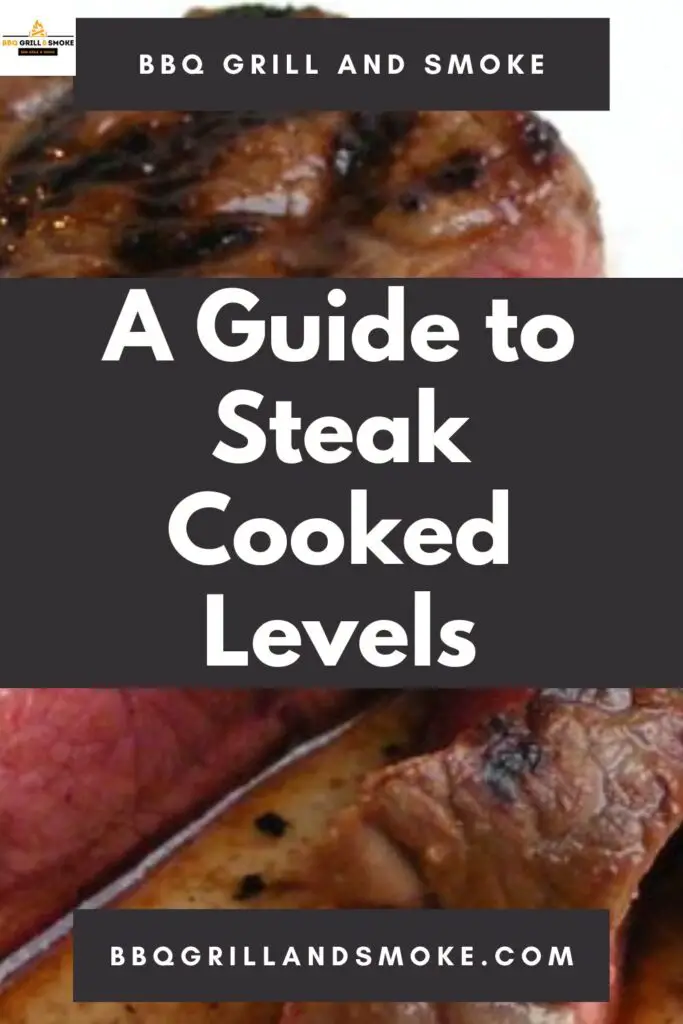A guide to steak cooked levels is what you definitely need, particularly with the fact that summer is finally here.
You are likely to hear the beautiful sound of millions of grills being lit across the country if you stand in your backyard and listen carefully.
There is certainly no better food to grill compared to a richly marbled, perfectly aged cut of USDA Prime steak.

However, it is wise to be certain you have the basics of steak doneness down before you finish tying up the strings on your “Kiss The Chef” apron; hence, comes this “A guide to steak cooked levels.”
You will learn everything you need to know with this guide to steak doneness.
Understanding Steak Doneness
All you have to do here is imagine a sizzling steak, perfectly grilled to your desired level of tenderness and juiciness.
And, since you are here, you are probably aware that there are different levels of doneness, ranging from rare to well-done.
That being said, each level has its own characteristics, which include texture, color, and juiciness.
What is Steak Doneness?
Steak doneness means the degree to which a steak is cooked, ranging from rare to well-done.
Each level of doneness imparts characteristics to the meat, and some of these characteristics include color, tenderness, and flavor.
Understanding the different levels of doneness will permit you to pick the perfect steak that is best suited for you.
Steak Cooked Levels
All excellent steaks need searing (for texture, flavor, and killing surface bacteria). But the doneness of your steak is determined by its internal temperature.
There are six main levels of doneness that you can cook a steak to.
Keep in mind to always pull your steak off the grill when it’s 5’ below the temperature you intend it to reach.
This is so due to the fact that your steak retains heat and will continue to cook and heat up for a few more minutes after you pull it off the grill, which will make its internal temperature rise.
This steak doneness guide will help you learn the difference between a rare steak and other steak cooking levels.
Blue Rare Steak (115 degrees Fahrenheit)
It is also commonly referred to as Very Rare, Black & Blue, Blood Rare, Bloody As Hell, or Pittsburgh Rare.
Blue Rare steaks are only seared on the outside, which means that the inside remains more or less completely uncooked and raw.
Blue rare steaks are mostly still cool on the inside and might be placed in an oven at a low temperature to warm.
Rare Steak Temp (120 degrees Fahrenheit)
Rare steaks come with a warm but extremely red center, which means that the surface has the delicious flavor and texture of the Maillard effect but also means that the steak’s fats have yet to have the chance to melt properly.
Rare is a great choice for low-fat steaks like tenderloins, thanks to this, but when it comes to well-marbled cuts like strips, porterhouse, and ribeyes, it should be avoided.
Medium Rare Steak Temp (130 degrees Fahrenheit)
This is the gold standard of steak doneness. Medium Rare refers to the best-tasting, succulent steak you can grill; just ask about any chef or steak aficionado.
The steak’s fat has had a chance to melt at this temperature, sharing butteriness and flavor, but not enough moisture has evaporated yet, which means an extremely tender, juicy, and plump steak.
A medium-rare steak is red at the center, along with a ring of pinkness between the crust and the center.
Medium Steak Temperature (140 degrees Fahrenheit)
A red center is absent in a medium steak; however, it is pink all over most of the steak.
Medium steaks hold on to the buttery, flavor-packed taste of Medium-Rare steaks but contain slightly less juiciness and tenderness because of the loss of moisture.
Medium Well Steak Temperature (150 degrees Fahrenheit)
Medium Well steaks still hold on to a little bit of pinkness and tenderness but have started to lose enough moisture that they will be drier and less tender compared to what most steak fanatics would care for.
Well Done Steak Temperature (160 degrees F)
According to most chefs and grillmasters, this level of doneness is poorly named; “Over-Done” would be a perfect match.
At that instant, enough moisture (and fat) has either evaporated or leaked from the steak that you will find your meat much drier and tougher than you would probably prefer it.
How to Use a Meat Thermometer
Using an instant-read thermometer or grilling thermometer is your best bet, given that the best way to determine when a steak is done is by checking the internal temperature of the meat.
Just stick the thermometer probe in the thickest part, away from the fat, bone, or gristle, when you want to test for the correct temperature.
It is essential that you remember that the meat will continue cooking with the remaining heat (continuing cooking) even after it is removed from the grill, by around 5 degrees F.
Go ahead and remove the steak from the heat at around 155 degrees Fahrenheit, give or take if you are going for a final internal temp of 160 degrees F.
How to Properly Prepare the Steak
The right preparation is the be-all and end-all if you want to grill a steak. You need to get it out of the fridge in good time in order to prepare steak cuts for the grill.
This is to say that the food to be grilled has to be removed from the fridge at least one hour before grilling; that way, the meat can reach room temp.
You must thaw it gently and slowly if you want to prepare a steak that is still in the freezer.
And, I strongly suggest that you put this in the refrigerator the evening before the grilling, and it can defrost slowly while cooling.
It’s also possible for you to forget to take the steak out of the freezer and don’t have enough time. Don’t worry, because I have a way for you to get out of that.
In this case, you will need a metal pot, a saucepan with hot water (not boiling), and the meat.
Now, turn the metal pot upside down and place the flat frozen steak in the freezer bag on top, then place the saucepan with the warm water on top.
The metal pot holds on to the cold from the meat, and it defrosts in no time and gently after a few minutes.
Make sure that you sear the meat on both sides over direct heat when you are preparing steak.
The time you need to cook a steak is determined by the thickness of the steak.
Immediately after the desired cooking point has been reached, the steak needs to cool for a few minutes over indirect heat.
The heat and meat juices are distributed even further in the meat during this time, and the core temp rises by 3 to 5 degrees Fahrenheit.
Final Thoughts on Steak Cooked Levels
Heat comes from the outside of the steak, however, you cook it.
This is to say that the outside cooks the fastest, whereas the middle of the steak cooks the slowest.
That’s actually good news, given that it creates an excellent char on the outside.
But the con of this is that the outside of the steak can overcook while you are waiting for the inside to come to room temperature.
That being said, all techniques for cooking steaks are tried to get the inside cooked evenly. The rule is that the longer it cooks, the harder the whole steak gets.
Now, this is all you need to know when it comes to steak cooking, temperatures, and meat doneness, which brings us to the end of this guide on “A guide to steak-cooked levels.”






